Bharatanatyam is a classical Indian dance form that originated in the temples of Tamil Nadu. It is a solo dance form that is traditionally performed by women. However, there have been male dancers who have made significant contributions to the art form. The first male dancer to give Bharatanatyam performances as a male was Ram Gopal.
Ram Gopal was a handsome person with a finely-tuned aesthetic sense. He was the son of a Rajasthani father and a Burmese mother. He learned the art of Bharatanatyam from Kolar Puttappa of Karnataka and then went on to perform in India and abroad. He was a trailblazer who broke gender norms and paved the way for other male dancers to follow.
Before Ram Gopal, Bharatanatyam was historically the preserve of devadasis. Temple dance, as well as its secular counterpart, was performed by them only. Men were not allowed to perform Bharatanatyam. However, Ram Gopal challenged this norm and proved that men could also excel in the art form.
Ram Gopal’s contribution to Bharatanatyam was not just limited to his performances. He also introduced new elements to the dance form, such as the use of lighting and innovative costumes. He collaborated with famous artists such as Salvador Dali and Pablo Picasso to create unique and visually stunning performances.
Ram Gopal’s legacy continues to inspire male dancers to take up Bharatanatyam. Today, there are male dancers who have mastered the classical dance form and are making their mark in the world of dance. Charles Ma, a mixed-race man, is one such dancer who has broken racial and gender stereotypes to become a teacher of Bharatanatyam in India.
In conclusion, Ram Gopal was the first male dancer to give Bharatanatyam performances as a male. He was a trailblazer who challenged gender norms and paved the way for other male dancers to follow. His contribution to Bharatanatyam was not just limited to his performances but also to the introduction of new elements to the dance form. His legacy continues to inspire male dancers to take up Bharatanatyam and make their mark in the world of dance.




